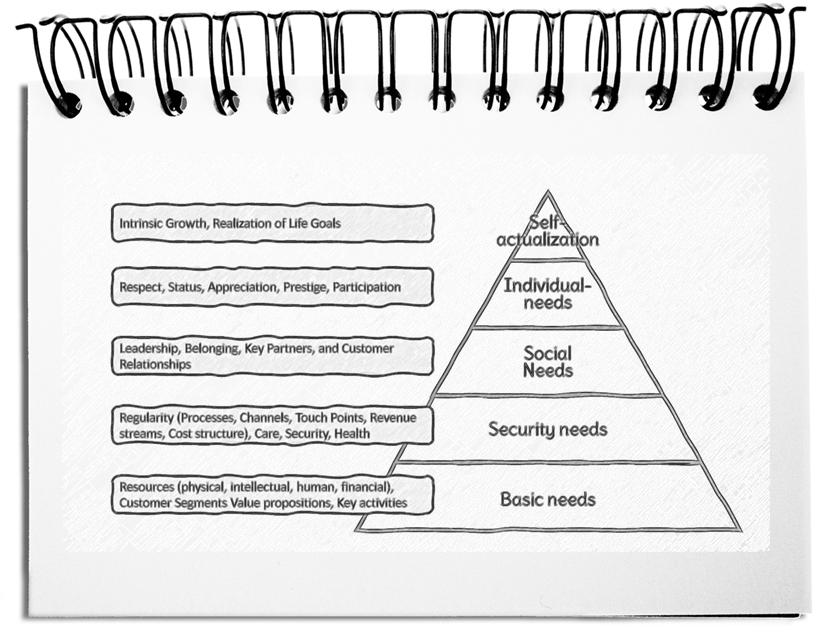When the affairs are not going as desired, you start looking for reasons, such as searching on the Internet. With the search term I am looking for customers, Google provides 10 billion links regarding marketing (e.g., finding customers, getting more clients, customer engagement, leads, customer database, digital marketing, etc.). This leads to tasks that completely absorbs you. It begins with the website, goes to content design and admin, smart keyword choices, regular social media feeds, and eventually to the adaption to search engines (SEO). Whether your deals subsequently improve is rather unlikely. The only beneficiaries is the SEO biz.
The Business Model Canvas provides ideas regarding customer segments, value propositions, channels, relationships, revenue streams, activities, resources, partners, and the distribution of the costs. To prioritize the missing aspects and discover the useful leverage points, you map these building blocks to Maslow’s pyramid. In this post, you find some examples. Subsequently, this results in what needs to be done – from the bottom to the top.
- Basic Needs
Your trade needs sufficient resources, the clear target groups, compelling value propositions, and feasible actions to maintain viability. Without these ingredients, you will not be able to deliver. The assortment should be understandable to customers, the necessary means be available, and you have to know what to do.
As long as these building blocks are only envisioned, it would help if you prepared primarily these biz basics – an adequately sized oven for the targeted quantities; the right number of bakers; money to procure ingredients; an appealing range of baked goods; last but not least you should master the relevant activities (e.g., purchasing, dough preparation, baking, and selling). - Security needs
Understandable rules and safeguards for the participants are needed to secure the transactions. Employees, partners, suppliers, and customers must be able to trust you. To achieve this, it is not enough to demand trust; you must earn it through appropriate actions. Additionally, the infrastructure and the to be delivered results should work together smoothly – the bakery and the salesroom fulfill the requirements; the baked goods are digestible, if not healthy; the price-performance ratio is acceptable; sales ensure survival. Without the design of the level below, this layer is not possible. - Social needs
This level takes care of the participants and their interaction. How are the external resources involved? How is the collaboration done (hopefully with a Win-Win)? How do you involve the employees? Even if the customer segments are already in place, you look at the customer relationships and set up the marketing efforts. Who are the customers, and what do they want? What media do you use to reach the customers? What can I offer them? Additionally, you find the organizational and operational structure on this layer – the organization and processes of purchasing, manufacturing, and sales; contracts with suppliers and partners; the website, posters, flyers, and social media activities. Satisfying social needs ensures that interaction runs frictionless. - Individual needs
After the company is up and running, you focus on the wishes of the individual. It is about increasing personal well-being through joint decision-making, treating each other with respect, and creating a stress-free working environment. This includes the values and their practical implementation that the people involved are proud of. Today’s bakery takes care of all areas – e.g. natural production, healthy ingredients, circular economy, and training for employees. Each person’s needs are considered, generate commitment and the reliable cooperation of all – which in the end promotes customer satisfaction. - Self-actualization
The top-level of Maslow’s pyramid is reached when it becomes possible to support those involved‘ life goals. In this case, the company promotes the individual’s growth by supporting the development of their personality and their projects outside the firm’s actual purpose – e.g., in sporting, artistic and social passions. In our case, this can extend far beyond the boundaries of the baking trade – e.g., support for hobbies, club activities, or social engagement. Satisfied employees contribute more proactively. Even the trade benefits when employees‘ creativity makes new offerings possible.
Bottom line: A look at Maslow’s pyramid prioritizes the business model’s building blocks according to their importance. To energize the revenue, work your way up from the bottom. As long as something is missing on a lower layer, that should be done first. The layers above need it as a foundation. As said initially, marketing is likely tackled too early since the relevant building blocks are not yet available. On the other hand, advertising efforts convey the feeling of caring for customers. But what matters most to customers are the offers and everything that is related. The showcase with its displays means nothing while there are no offers. This makes it clear that the lower levels are most important – in particular, sufficient resources, the availability of customers, a compelling value proposition, and the existing capabilities for the required activities.


